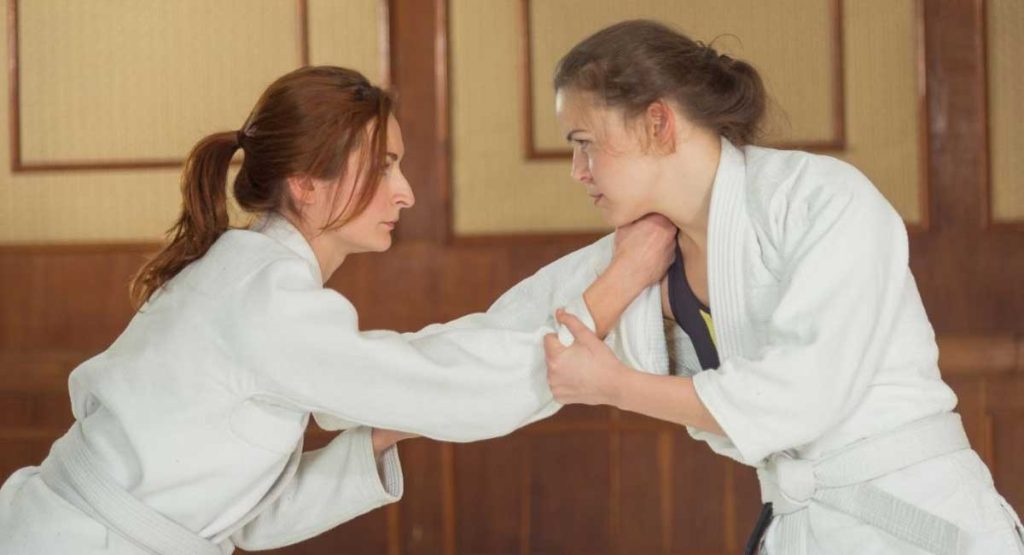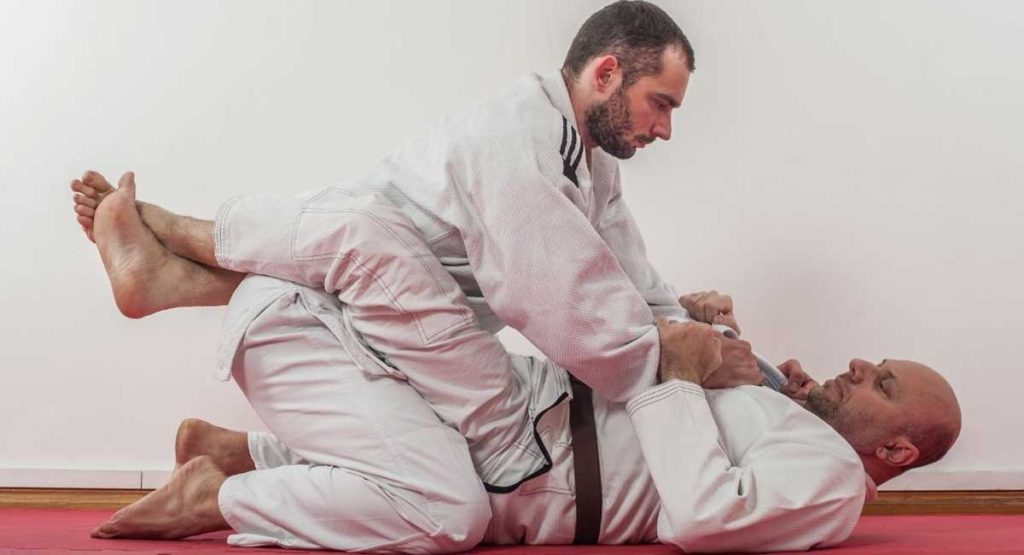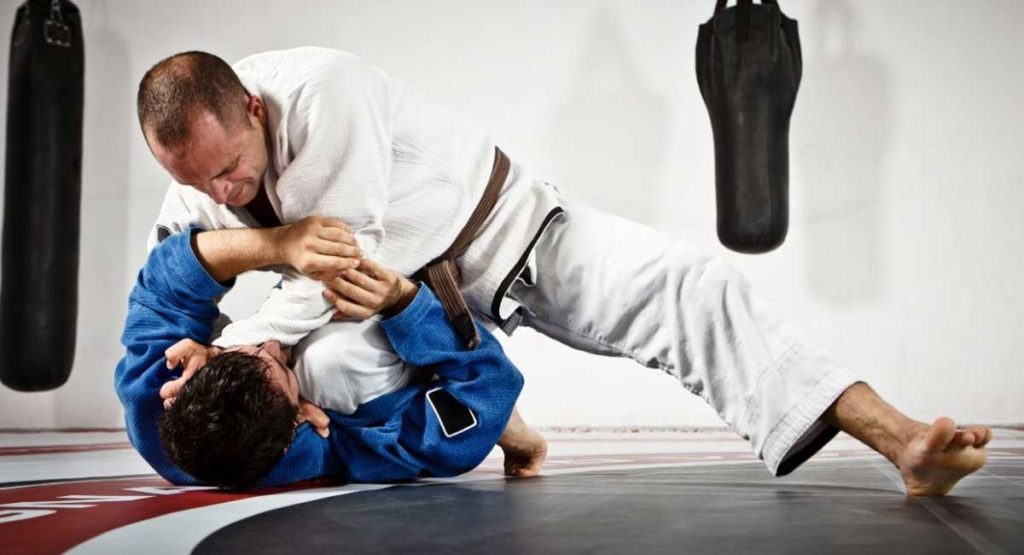Jiu jitsu is a type of martial art with origins in Japan. It developed some time in the eighth century where its earliest forms were a patchwork of other Japanese martial arts and sumo wrestling. It was meant to be a close-quarters fighting style that relies heavily on grappling.
Over centuries and with input from other cultures, jiu jitsu evolved to become its modern form: a martial art that focuses on throwing, pinning, and joint-locking methods. It also became the source of many subtypes, some of which include sambo, Brazilian jiu jitsu , and judo.

Origins of Modern Jiu Jitsu
In fact, Jiu jitsu is not homogeneous: there are over 2000 styles that have developed over the last few hundred years. Different schools or dojos of jiu jitsu sprang up across Japan and elsewhere. All of these subtypes still focus on grappling and using an opponent’s might against them.
Jiu jitsu is unique among different martial arts in that it is more defense-oriented than offense-oriented. A jiu jitsu practitioner relies on throws, pins, and other locking methods which distinguish it from other defensive martial arts. It is not as rigid as the southern shaolin style, which requires sturdy footing to prevent being knocked over. Jui jitso’s nature is gentler and more flexible — such that any practitioner can turn even a larger opponent’s strength against him.
It also does not rely on fast movements such as punches and kicks, as well as weapons of any kind. However, it still uses some striking methods.
Since jiu jitsu requires no weapons, the practitioner uses their limbs as an extension of their body — not to hurt their opponent, but simply to disable them.
Jiu Jitsu as a Sport
Some aspects of jiu jitsu were remade so that it could fit into competitive sports. In this way, it is not intended to harm or kill opponents.
That is the responsibility of the Sport Jiu-Jitsu International Federation (SJJIF), a governing body that manages jiu jitsu for competitive sports. This organization does not involve itself with traditional jiu jitsu in any way. Most of its rules are geared towards Brazilian jiu jitsu.
But what is Brazilian jiu jitsu and why has it become so popular in competitive sports these days?
Brazilian Jiu Jitsu: A Precursor to Modern MMA
Early History
Brazilian jiu jitsu, or BJJ, is a form of jiu jitsu that was first developed in the 1920s by the Gracie brothers.
Its popularity grew continuously until it became recognized in the mixed martial arts community. However, the roots of BJJ were themselves derived from the so-called Kodokan-style jujutsu, whose founder, Kano Jigoro, thought that they were teaching their students the most effective methods of jujutsu.
Such methods are also seen in judo nowadays, including live sparring sessions known as randori. When students practice randori, they involve throwing, taking down, locking, and choking opponents without being “offense oriented.”
One of Kano’s students, Maeda Mitsuo, went to Brazil where they met Carlos Gracie, their future student. Gracie was well-versed in “ne waza”, a form of jiu jitsu that Maeda was known for. Originally, size and strength mattered, which meant that most practitioners would have to be on par with their opponents.
Eventually, the martial art was modified so that anyone regardless of size or strength could practice it without disadvantage.
Using the new techniques, the Gracie family demonstrated in various matches that BJJ was so effective and versatile such that whenever they competed against other martial arts practitioners, they rarely lost.
Brazilian Jiu Jitsu Today
Outside Brazil, BJJ was an unfamiliar term for practitioners of other martial arts until Rorion Gracie, nephew of Carlos, introduced the art to the United States in the 1970s. To boost BJJ’s popularity, Rorion and their team established the Ultimate Fighting Championship (UFC), a contest that involves fighters from every martial art out there.
In the first-ever UFC competition, Royce, Rorion’s younger brother, represented BJJ. they surprised everyone, for even though they looked small compared to their peers, they eventually won the championship.
His performance demonstrated to the world the effectiveness of BJJ and how anyone into martial arts could benefit from it. Royce won a few more championships after their debut, after which many martial arts enthusiasts worldwide began to train for BJJ, eventually incorporating it into mixed martial arts as a whole.
Like its parent martial art, BJJ focuses on grappling and ground-fighting methods. It does not require striking movements such as punching or kicking because BJJ is still defense-oriented. Practitioners of BJJ can still defend themselves against bigger opponents by using their strength against them.
Definition of Terms
- Jiu jitsu – a martial art that prioritizes close-combat techniques in order to subdue opponents.
- SJJIF – The Sport Jiu-jitsu International Federation, the main organization that handles sport jiu jitsu, including Brazilian jiu jitsu.
- Brazilian jiu jitsu (BJJ) – an offshoot of jiu jitsu that relies on grappling and other close-quarters defensive moves to disable an opponent.
- Newaza – Japanese for “ground techniques”; these are jiu jitsu techniques that involve the ground in order to hold and disable an opponent’s movements.
- Gi– a form of BJJ that allows the grabbing of an opponent’s clothes.
- No Gi– a form of BJJ that does not allow the grabbing of an opponent’s clothes.
Rules of the Sport
Jiu jitsu, as well as its subsets, is governed by rules set by the SJJIF. The organization understands that the martial art itself is dynamic and constantly evolving, which means that the rules are also updated accordingly.
The rules of sport jiu jitsu are summarized into the Sport Jiu-Jitsu International Federation Rulebook. It includes rules that must be observed involving doping control, qualifications, matchmaking, belt systems, and penalties.
This rulebook is free for download at the SJJIF’s official website. It is a comprehensive document that includes everything about sport jiu jitsu.
In the succeeding sections, the rules on how to win a jiu jitsu match are discussed.
Bracketing
According to the rulebook, all SJJIF-supervised tournaments are set up as single elimination competitions. Pairs of players are allowed to compete per round, and the winner of the pair advances to the next round.
However, the bracketing system is usually predetermined based on the number of players competing. Some of these systems involve qualifying some participants into the next round. Below is a list of bracketing systems:
- 2-man Bracket – only two players compete, and the winner is awarded gold.
- 3-man Bracket – the first two players compete and whoever wins between them automatically goes to the finals, while the loser competes with the third player in the second match. Whoever wins in the second match competes with the winner of the first match for the gold.
- 4-man Bracket– there are two pairs of players; the winners for each pair move on to the finals, while the losers compete for third place.
- 5-man Bracket – two out of five players compete for a slot in the semifinals, while the other three players are automatically set to compete in the semifinals. The system resembles a 4-man Bracket once the loser of the first match is removed.
- 6-man Bracket – two pairs of players compete for a slot in the semifinals, while the other two players are automatically set to compete in the semifinals. The winners between the first pairs that competed advance to the semi-finals, and the game resembles a 4-man Bracket.
- 8-man Bracket – four pairs of players compete in the quarterfinals (first match), and the winners for each pair advance to the semifinals. From there, the game resembles a 4-man Bracket.
- 16-man Bracket – eight pairs of players compete in the first round, and the winners from each pair advance to the quarterfinals. From here, the game resembles an 8-man Bracket.
The player’s position on the bracketing system also matters, as it helps them become identified. Since matches occur between pairs, the top player wears either an additional belt or an ankle band, both in alternating green and yellow, depending on whether the competition is Gi or No Gi. Meanwhile, the bottom player does not wear either.
Age Divisions
Athletes are grouped in age divisions based on their year of birth only. Meanwhile, boys and girls above 12 years old cannot be grouped in the same division. This means that a boy and a girl cannot be part of the same bracket. The same goes for adult men and women.
Below is a list of age divisions and their corresponding belt ranks.
Kid Belt System
This is applicable only for children aged 4 – 15.
- Kid 1 (KD1) – 4/5 years old, highest level is gray belt
- Kid 2 (KD2) – 6/7 years old, highest level is yellow belt
- Kid 3 (KD3) – 8/9 years old, same belt rank as KD2
- Kid 4 (KD4) – 10/11 years old, highest level is orange belt
- Kid 5 (KD5) – 12/13 years old, highest level is green belt
- Kid 6 (KD6) – 14/15 years old, same belt rank as KD5
Juvenile and Adult Belt System
This is applicable only for players at least 16 years of age.
- Juvenile 16-17 (JV16-17) – 16/17 years old, highest level is purple belt
- Adult 18 (AD18) – at least 18 years old, highest level is black belt
- Master “xx” (MTxx) – at least xx years old, highest level is black belt
- There are 7 different Master age divisions: 30, 36, 41, 46, 51, 56, and 61.
Weight Divisions
To prevent injuries and biases, jiu jitsu players are encouraged to compete at their normal weight. At the official weigh-in, they must put their uniforms on. They do not need to have shoes or other things on them, and they can only weigh in once.
Whether the competition is Gi or No Gi, there are up to 10 weight divisions in sport jiu jitsu. They are:
- Rooster
- Super Feather
- Feather
- Light
- Middle
- Medium Heavy
- Heavy
- Super Heavy
- Ultra Heavy
- Open
However, there is no open weight division for children — it is only applicable to juvenile and adult weight categories. Furthermore, there is a separate weight division list for adapted jiu jitsu and special events for adults.
Match Conclusions
In sport jiu jitsu, no match ends in a draw; there always has to be a winner. Therefore, there are eight factors on which matches would be concluded:
- Points – the player with more points is declared the winner at the end of the match. In this case, the match is not ended prematurely.
- One-man Bracket Result – the player receives no points but gets a gold medal. In other words, they or she wins by default.
- Submission – if one of the athletes is seen submitting or giving up using physical or verbal signals, the other athlete is declared the winner. This happens even if the submitting athlete has more points than the other.
Therefore, when one player is about to give up, the last player standing wins. However, if a player submits because the other player fought improperly, the other player may face violations.
When this happens, the referee decides whether the match continues or not.
-
- The referees usually decide wisely whether to end a match when one player is about to give up. It depends on which categories the competitors are part of.
For instance, when both athletes are children, the last player standing wins if the other player is already in physical danger and unable to continue. This player does not need to signal submission. However, in adult matches, the referee often lets the competition continue until one of the players gives up.
- An athlete may signal submission by: (1) tapping with either their hands or feet against any surface, (2) requesting the referee that the competition be stopped, (3) their coach requesting the referee to stop the match, or (4) screaming in pain.
- Opponent’s Inability to Continue – one of the competitors wins the match if either competitor is injured or the medical attendant deems them unable to continue, as long as no bad technique is applied.
A player can also be considered unable to continue if they or she experiences cramps or spasms. However, this is still up to the referee to determine.
- Opponent’s Loss of Consciousness – one of the players wins if the other player loses consciousness, as long as it is unintentional. If they suffer a concussion, they cannot play again in the tournament and must be treated by medical professionals.
- Referee Decision/Double Injury – in the case that both players cannot continue the match, the player with the most points wins the match. But, if both players are equal in points, the referee looks at how the players performed. Whoever had a better performance overall wins.
Alternatively, both players may be disqualified.
Points System
A player can either win or lose points depending on their moves during the match. It is the referee’s job to take note of these moves and grade them accordingly.

Two-point Moves
- Takedown – a player drops their opponent from a standing position. Here are some guidelines for a valid takedown:
- A player takes down their opponent with their feet never leaving the competition area.
- A player does a double leg and the opponent pulls guard.
- A competitor takes down their opponent whose one knee (and both feet) is on the ground.
- Knee on Belly – a player on top puts their knee on the opponent’s belly and must hold the position firmly for 3 seconds. Otherwise, no point will be awarded.
- Sweep – a player in guard position inverts their opponent’s position by getting on top of them. Here are some guidelines to make proper sweeps:
- The player must have a form of guard established, such as when they are on their back or side and when they use their legs to keep distance from their opponent.
- A sweep can be done with either the arms or legs.
- A player gets points if they successfully sweep their opponent and keep the position for three seconds.
- A player can sweep, take down their opponent, and keep the position for three seconds.
- If a competitor on top attempts a submission and ends up under their opponent for three seconds, the opponent wins sweep points.
- The player also wins sweep points if they attempt a submission, sweep their opponent, and land on top of them for three seconds.
- Illegal sweep attempts result in either penalties or disqualification.
- Unintentional Out-of-Bounds During Submission – whenever a player trying to escape from a submission goes out of bounds, the referee stops and restarts the match. The other player who is applying the earlier submission wins 2 points.
Three-point Moves
- Passing the Guard – a competitor maneuvers from a guard position to a position where they are on top of their opponent who cannot move or escape. Here are some guidelines for passing the guard:
- The player must have a form of guard established, such as when they are on their back or side and when they use their legs to keep distance from their opponent.
- A competitor establishes a controlling position past their opponent’s guard for three seconds.
- No points are awarded if the player on guard gets on their knees or stands up.
- Additional points for mount are awarded if the player passes the guard and gets on a mount position.
Four-point Moves
- Mount – a competitor faces their opponent’s head while sitting on their torso. Here are some guidelines for a proper mount:
- Points are awarded for the player who keeps the mount position for three seconds.
- No points are awarded if a competitor’s feet or knees are on the opponent’s leg.
- Taking the Back – an athlete is in this position when their chest is against their opponent’s back and their arms and legs are wrapped around their opponent. Here are some guidelines for a proper position:
- Points are awarded for the player who keeps this position for three seconds.
- No points are awarded if the player cannot assume a full grip with their arms and legs.
Penalties
Penalties are given when players exhibit bad conduct during matches. Bad conduct includes incorrect techniques and intentional injuries. They are classified into minor fouls, stalling, and serious fouls.
Here are some examples of a player committing minor fouls during the match:
- Whenever they kneel, sit, or lie down before engaging their opponent.
- Whenever they disengage their opponent by stepping out of the competition area.
- Whenever they take off their GI with the intention of stopping the match.
- Whenever they disobey a referee’s order.
- Whenever they grab their opponent’s uniform in a No Gi match.
- Whenever they put a hand or foot on their opponent’s face.
Stalling, or a lack of combativeness, is defined by lack of positional progression in a match. A stalling player is seen as slacking around and requires a referee’s attention.
Here are some examples of a stalling player:
- Whenever they prevent their opponent from seeking positional progression from guard.
- Whenever they, as a bottom player, wrap their arms around their opponent’s back without intending to achieve a submission or score.
Penalties are given as -1 point per offense committed. Players can only have up to two negative points because they will be disqualified if they receive a third negative point.
Meanwhile, serious fouls result in immediate disqualification for the offending player. Here are some examples of a serious foul:
- Using punches or kicks to either hurt or gain an unfair advantage.
- Pulling hair, biting, or striking eyes or private parts.
- Using obscene language.
- Using either the player’s or their opponent’s belt to assist in a choke or similar circumstance.
- Covering their opponent’s nose or mouth using their hands.
- Not wearing proper underwear.
- Applying slippery substances on any part of the body.
Conclusion
Now that you know what jiu jitsu is and how it should be played properly in matches, you first need to practice the basics before you sign up for tournaments. It takes a lot of discipline and skill to perform as one of the best.
Always remember to play by the rules set by the SJJIF if you want to participate in sport jiu jitsu.

